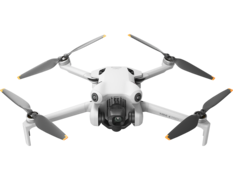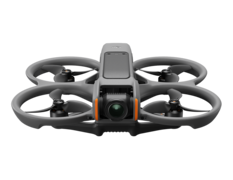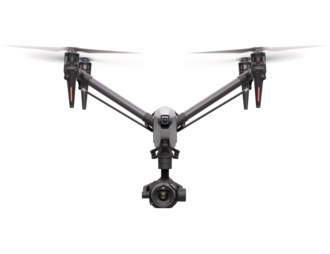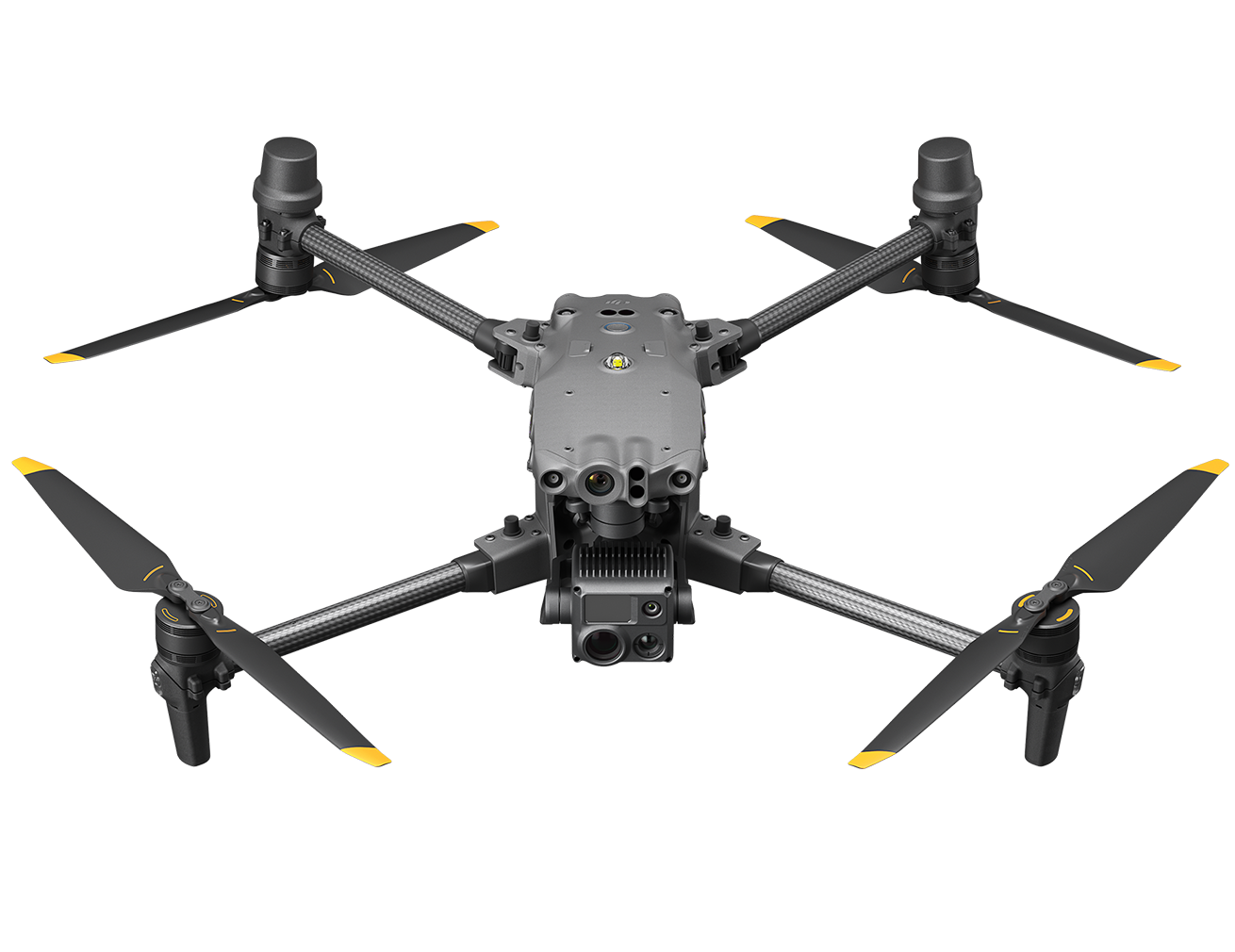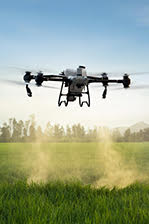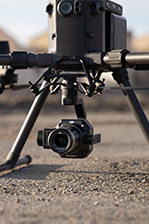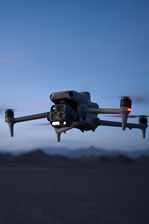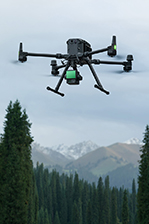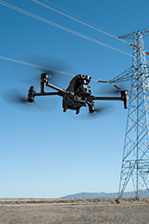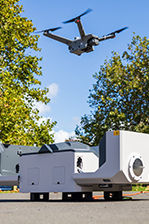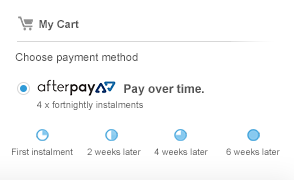DJI Agras T100 Three Battery Combo
The T100 Agricultural Drone, perfected over 12 years, boasts a 100kg payload and doubled operational efficiency for spraying, spreading, and lifting. It integrates industry-leading safety systems and algorithms for a secure and intelligent user experience
DJI Agras T100 Three Battery Combo
The DJI Agras T100 Three Battery Combo includes two extra DB2160 Intelligent Flight Batteries, giving you more time in the air and fewer interruptions in the field. Ideal for operators needing longer runtimes and faster turnaround between flights.
Big Drone, Big Jobs.
The T100 Agricultural Drone, a groundbreaking creation twelve years in the making, boasts a maximum payload of 100 kg[1]. Its operational efficiency is doubled, supporting multiple application scenarios, including spraying, spreading, and lifting tasks. Featuring industry-leading safety systems[2] and advanced algorithms, it delivers unparalleled safety performance and an intelligent operational experience.
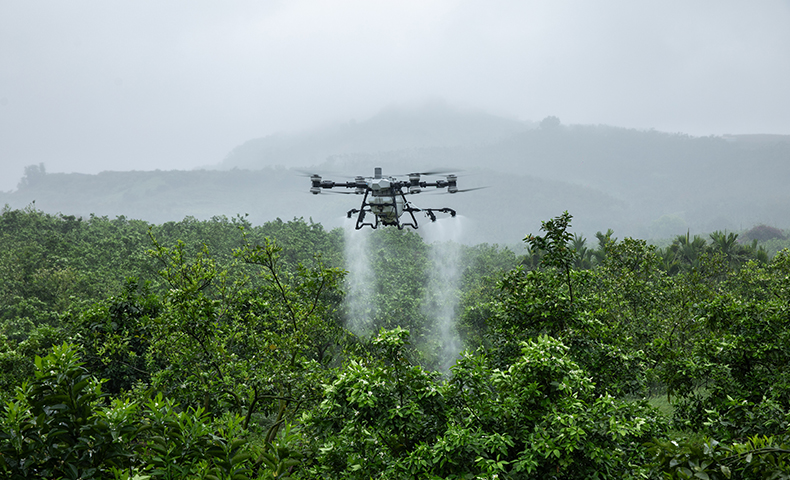
Spraying System
Efficient operation, Outstanding performance.
The T100 comes equipped with a 100 L tank and dual atomizing centrifugal sprinklers, enabling faster flight speeds, wider spray coverage, and higher operation efficiency for large-scale field applications. Orchard users can choose an optional mist sprinkler set, which upgrades flow rates and atomization effects to penetrate dense canopies and reach the undersides of leaves on tall, thickly-canopied trees, ensuring outstanding versatility and performance across various agricultural tasks.
Field Operations
36% Increase in Operation Efficiency [27]
30L/min High Flow Rate
5-13m Effective Spray Width [8]
20m/s Maximum flight speed [6]
Orchard Operations
40L/min Four Sprinklers
25% Increase in Effective Spray Width [7]
65% Increase in Leaf Underside Coverage [7]
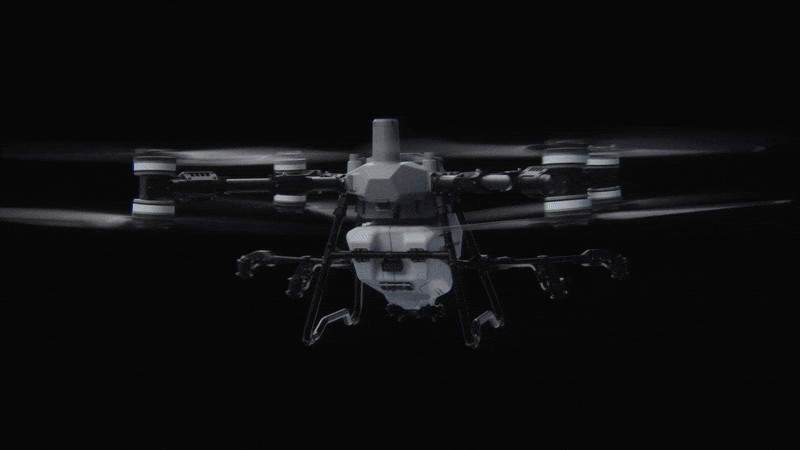
Water-Cooled Mist Sprinkler (Optional) - Fine droplets as small as 50 μm[23] penetrate canopies for comprehensive leaf coverage. A new liquid flow path helps dissipate dual centrifugal motor heat for durability and longevity.
Dual Atomization Centrifugal Sprinkler - New flow channel design, particle size range 50-500 μm[9], suitable for most operational scenarios.
Magnetic Drive Impeller Pumps - Corrosion-resistant, stable, and reliable, an optimized impeller structure and increased chamber volume meet the high flow demands of orchard scenarios.
Rear Four Sprinklers Array - It expands the spray width for orchard operations while maintaining uniform coverage. It also minimizes visual interference from mist, enhancing operational reliability and precision.
Dual-Channel Electromagnetic Flow Meter - Real-time precise flow detection and dynamic control ensures high-precision operations. It avoids direct contact with the liquid, preventing corrosion and enhancing durability.
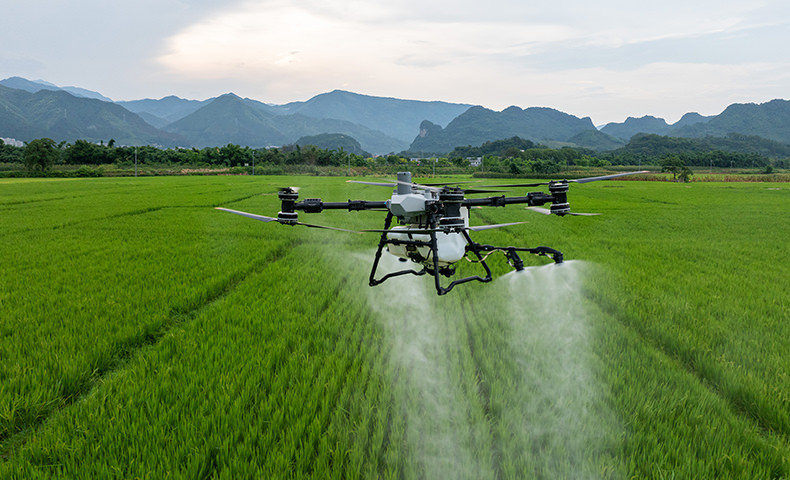
Spreading System
Bigger Loads, Faster Flow, Better Efficiency
The T100 Spreading System has been fully upgraded, with double the load capacity, and a 270%[7] increase in flow rate. Equipped with a brand-new screw feeder, it is suitable for various granulars and can handle spreading scenarios in large fields, orchards, aquaculture, and more.
150L(100kg) High Capacity Spreading Tank[3]
66% Increase in Operation Efficiency[27]
400kg/min Ultra-High Flow Rate[4]
10m Effective Spreading Width[10]
20m/s Maximum flight speed[6]
Brand-New Screw Feeder - Spreading accuracy doubled, flow rate increased by 270%[7], and granulars applicability further enhanced.
High-Precision Weighing Sensor - Provides real-time, accurate display of granular quantity, allowing for precise usage and refilling, effectively minimizing waste. Automatic flow rate calibration and cloud-save operation templates, making spreading operation more accurate and convenient.
Centrifugal Spreader Disc - Ensures uniform spreading across the entire flow range with outstanding results. Features a stainless steel cap for durability and strength.
Large Loading Gate - Allows for easy and convenient bulk loading.
Four Feeder Types
Supports four interchangeable feeder sizes for precise flow and greater adaptability[11] across seeding, fertilizing, and feeding.
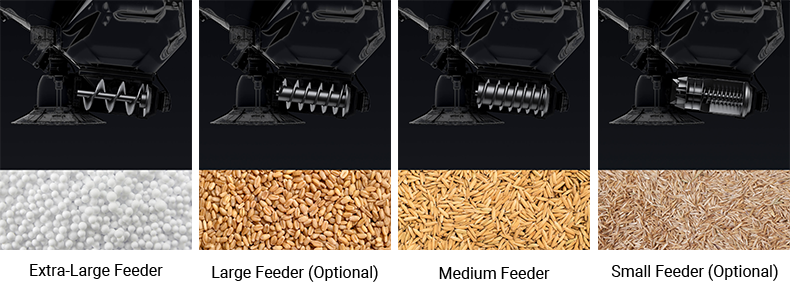
Extra-Large Feeder
Suitable for granulars such as fertilizers, wheat seeds, granular fungicides, feed, etc.
Recommended application rate: 75-750 kg per hectare.
Recommended particle size: 0.5-10 mm
Large Feeder (Optional)
Suitable for granulars such as rice seeds, cover crop seeds, etc.
Recommended application rate: 75-270 kg per hectare.
Recommended particle size: 4-10 mm
Medium Feeder
Suitable for granulars such as rice seeds.
Recommended application rate: 22.5-120 kg per hectare.
Recommended particle size: 4-6 mm
Small Feeder (Optional)
Suitable for granulars such as rapeseed, granular herbicides, grass seeds, granular insecticides, etc.
Recommended application rate: 3-22.5 kg per hectare.
Recommended particle size: 0.5-4 mm.
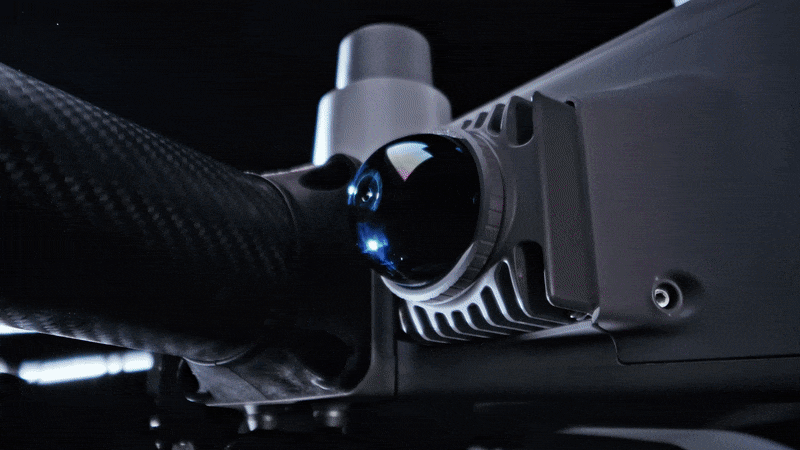
Safety System
Industry-Leading Safety System[2], Safer With Every Flight
Omnidirectional Sensing, Precise Obstacle Detection[2]
T100 is equipped with advanced technologies, including a new LiDAR, millimeter-wave radar, and a Penta-Vision system[12]. These features enable comprehensive environmental awareness, allowing for precise obstacle detection.
LiDAR - Capable of capturing dense spatial point cloud up to 300,000 points per second, providing a detailed view of complex terrains.
Millimeter-Wave Radar - The front radar performs 5,000 vertical airspace scans per second combined with 360° horizontal mechanical rotation scanning, along with a rear radar[12] offering a more comprehensive detection range.
Penta-Vision System [2] - The quad-vision system, paired with an FPV low-light full-color camera, facilitates unrestricted viewing of flight scenes in front, behind, left, right, and below, while intelligently identifying obstacles. The FPV camera employs virtual gimbal technology, offering an ultra-wide field of view complemented by stabilization algorithms, to achieve electronic image stabilization for smoother, more fluid footage.
Night Navigation Light [13] - In addition to the existing low beam lights, new front-facing high beams and downward supplemental lighting have been added, ensuring safer nighttime operations.
Smarter Obstacle Bypassing [2]
Obstacle Type Detection [2] - The system can detect various obstacle types, including wires[29], poles, high-voltage towers, and trees. It intelligently selects the optimal path, ensuring smooth and seamless bypassing around obstacles.
Automatic Obstacle Position Memory - The system automatically remembers obstacle locations, enabling more precise bypassing during subsequent flights. Users can save obstacles to a field with a single click, increasing safety with every flight.
Terrain Following Without Mapping - The system can achieve Terrain Following of slopes up to 90° without prior mapping. It also supports intelligent obstacle bypassing[2], addressing the operational requirements of most mountainous and orchard environments with efficiency and precision.
AR Safety Assistance
Real-Time LiDAR Point Cloud Display - Real-time LiDAR point cloud visualization offers clearer and more intuitive obstacle detection compared to FPV. This is especially valuable when dealing with small obstacles or operating at night, ensuring enhanced operational awareness and safety.[2]
AR Display for People, Vehicles, and Obstacles [14] - Detect utility pole and vehicles during takeoff and landing with AR visualization for enhanced safety. During flight, it further enables AR display of obstacle types and distances, ensuring precise and informed operations in real time [14].
AR Flight Route Prompts[14] - The system generates AR flight paths to assist with route guidance, providing enhanced precision and efficiency for every operation.
AR Return-To-Home Projection[14] - AR display of return-to-home point locations and safe landing projections assist with return and landing operations, ensuring greater accuracy and safety for every operation.
Enhanced Obstacle Avoidance Capabilities
With advanced multi-sensor fusion and upgraded algorithms, the T100 achieves a higher success rate in avoiding various obstacles. Its precision in detecting smaller obstacles is significantly improved, ensuring safer and more reliable operations[2].
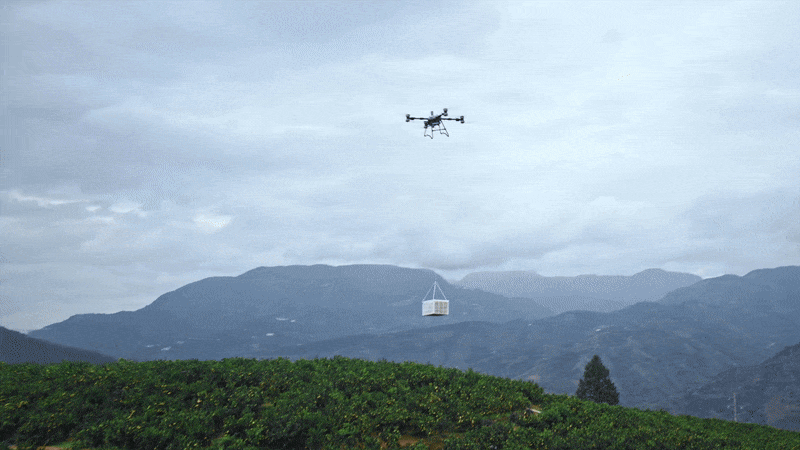
Lift System
Your Transport Assistant
The T100 transforms into a transport solution. With a lifting maximum capacity of 80 kg[28]. Features like auto balance control , weight detection, and automatic navigation to loading and unloading points make it adaptable to various agricultural transport scenarios.
Auto Balance Control - Utilizing a triaxial force sensor, the drone can automatically adjust its posture during flight to eliminate swinging, ensuring safer operations.
Real-Time Weighing - A triaxial force sensor provides real-time weight monitoring to prevent overloading and ensure operational safety.
Marking Loading and Unloading Points by Mobile - Operators can use their mobile phones, in conjunction with the RTK module, to add load and unload points, which are then synced to the remote controller. Pilots can quickly locate destinations using AR projection on the controller.
Automatic Flight - Freely select loading and unloading points and reach them with a single click.
Upgraded Lifting System - The optional dual battery version has a lifting capacity of 80kg[28], suitable for scenarios requiring long endurance. For extreme situations where hanging cargo gets trapped or tangled, you have the option to heat and cut the cable, freeing the drone.
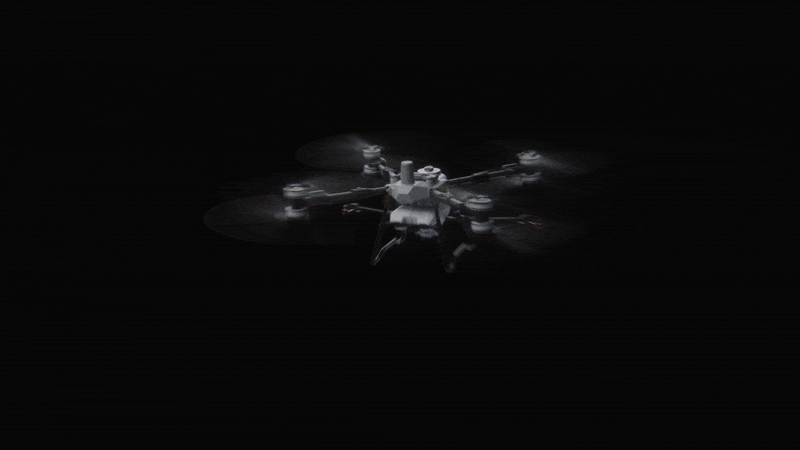
Propulsion System
Powerful, Efficient, Reliable Under High Temperatures
The coaxial dual-rotor design, paired with carbon fiber propellers, delivers a comprehensive upgrade in performance, efficiency, and safety redundancy.
Powerful Performance
82 kg Single-Axis Max Thrust
20 m/s Max Speed[6]
Compact Size, High Load Capacity
Energy Efficiency
39%[7] Increase in Full-Load Power Efficiency
Safety Redundancy
Propeller Stop Protection
Low battery performance under heavy load
Efficient Operations
Increase in Spray Width[15]
Increase in Operation Speed[15]
Enhanced Penetration for Orchards
62-Inch Carbon Fiber Propellers - Carbon fiber propellers offer greater rigidity and lighter weight, resisting deformation even at high temperatures. With optimized airfoil and increased diameter, efficiency is improved by 32%[7].
Motors and ESCs - Larger motors, more torque. 420A electronic speed controllers ensure stable and reliable operation, delivering faster response times.
DJI RC Plus
Easy Control for New and Experienced Pilots
DJI RC Plus features a 7-inch high-brightness screen that is 16%[7] brighter for clear visibility under sunlight. Both internal and external battery life are extended by 30 minutes[7]. New backlit buttons enhance nighttime operation, and customizable physical buttons offer flexible control.
Get Started With Ease for New users
Simply complete the field planning, and operate with one click, without the need for manual intervention.
Step 1: Easy Field Planning - Choose from multiple planning methods. Once the field is planed, the flight path is automatically generated.
Step 2: One-Click Fully Automatic Operation - Easily call up parameter templates with a single click for convenience and speed.
Step 3: Smart Return to Home - Automatically returns home when out of pesticide or low on battery.
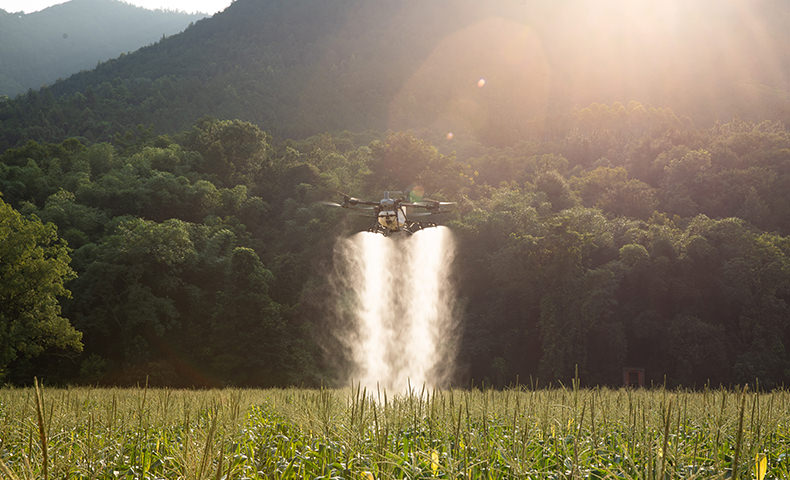
Elevate Precision and Efficiency for Experienced Pilots
Experience smooth and intuitive manual operation paired with a range of powerful, efficient assistive features. Tackle even the most challenging terrains with confidence and ease.
Multi Fields Operations - Efficiently plan multiple adjacent plots in a single go. Enabling continuous operations without interruptions (in fields or orchards).
Practical Features for Manual Mode - Simplify operations on complex small plots with practical tools like one-click plot saving and one-click return to breakpoints, ensuring efficient and stress-free workflows.
Free Flight Paths - Adapt effortlessly to diverse scenarios, including mixed crops, intercropping, and paddy fields. Achieve greater operational flexibility for more efficient workflows.
LiDAR Mapping [16] - Mapping up to 20 hectares of large fields or 10 hectares of orchards per flight[17]. The map is reconstructed in real-time on the remote controller, with rapid delivery upon landing[18]. Point cloud density increased, power line detection rate improved by 80%[7].
Rigorous Testing Standards
The T100 has undergone 700 hours of reliability testing, including real-flight aging, accelerated component fatigue, and extreme temperature evaluations. These ensure stability and reliability, delivering unmatched performance under various conditions.
Transmission System
Seamless Signal Stability
The upgraded O4 video transmission algorithm ensures constant signal availabilitys. O4 Relay it's designed to excel in challenging signal conditions, delivering seamless and efficient operations.
O4 Transmission - An upgraded transmission algorithm enhances the range while maintaining smooth and stable visuals for consistent performance.
D-RTK 3 AG (Optional) - Enabling plug-and-play centimeter-level positioning without the need to configure coordinates. It ensures precision across the entire operation.
RTK High-Precision Positioning Module - Use in conjunction with the remote controller and smartphone for precise location marking.
O4 Relay (Optional) - A Relay can ensure smooth operations in scenarios that have signal interference.
Power System
Ultra-Fast Charging, Energy-Efficient Design
The DB2160 Intelligent Flight Battery has an increased capacity and lighter built, offering ultra fast charging while reducing fuel consumption. Its innovative triple air-channel cooling system disperses heat through airflow, ensuring safe and stable energy management with efficient cooling even during flight.(It varies between countries.)
DB2160 Intelligent Flight Battery
41 Ah
1500 charge cycles under warranty[19]
500 A high-power connector
Weight: 14.7 kg
Ergonomic handle
C10000 Intelligent Power Supply
Single-phase power input
9000 W fast charging[21][22]
Adaptive power protection
1.5 m charging cable
C12000 Intelligent Power Supply
Tri-phase power input
12000 W fast charging[21]
Adaptive power protection
1.8 m charging cable
Notes
*The product is only available in certain countries. The appearance of the product is subject to the actual product. For details, please contact your local dealer.
[1] Measured at sea level, DJI Agriculture App intelligently recommends the appropriate loading weight based on the current status of the aircraft, environmental conditions, and operational tasks. Users are advised not to exceed the recommended maximum weight of the loaded granulars, may impact flight safety.
[2] The effective sensing range and its ability to avoid and bypass obstacles will vary depending on the ambient light, rain, fog, and the material, position, shape, and other properties of the obstacles. Downward sensing is used to assist in Terrain Following flight and altitude stabilization, while other directions assist with obstacle avoidance. Any collision between the bottom of the aircraft and obstacles shall be the customer's responsibility. In scenarios without linear obstacles, if a collision occurs at speeds up to 13.8 m/s resulting in aircraft damage, responsibility can be determined through log analysis, and the aircraft may be eligible for free warranty if non-human causes are identified. If there are linear obstacles like wires or guy wires on utility poles, please mark them as obstacles; otherwise, failure to bypass them will be the customer's responsibility.
- Note 1. Downward sensing assists in Terrain Following flight. If the bottom collides with obstacles, it is considered user responsibility. - Note 2. Due to limitations in safety system performance, the aircraft cannot automatically avoid moving objects, and accidents of this nature will be attributed to user responsibility.
[3] Different granular densities vary, and the maximum load should not exceed 100 kilograms.
[4] Measured with compound fertilizer. The maximum flow rate may vary due to differences in granule size, density, and surface smoothness of different fertilizers.
[5] A weight of 100 kg is measured below the triaxial force sensor (including the weight of the sling, and hook). Data was measured at sea level. The DJI Agras app will recommend the payload weight according to the current status and surroundings of the aircraft. When adding materials, the maximum weight should not exceed the recommended value, otherwise flight safety may be compromised. Users must comply with local regulations during operation.
[6] The actual operation speed of the drone is related to the terrain slope; the steeper the slope, the lower the operation speed. The maximum operating speed varies by country and operational mode, and is subject to local regulations and the actual firmware version.
[7] Compared to the Agras T50 drone and its supporting equipment. Test results may vary based on different testing conditions.
[8] The effective spray width of the spraying system depends on the actual working scenario.
[9] The droplet diameter is measured by a laser particle size analyzer, with a 50-micron diameter using the DV50 standard.
[10] Measured at an operating height of 3 meters with a spinning disc speed of 1,100 r/min and a uniformity requirement of CV < 30%. Higher disc speeds and flight altitudes increase the spreading width.
[11] Suitable for granulars ranging from 0.5 to 10 mm in size. Clumps, straw, woven bags, and impurities, as well as humidity, density, hardness, and shape, can affect spreading adaptability and precision.
[12] To ensure the radar's sensing performance is fully utilized, make sure the radar surface is clean before operation. If necessary, wipe and clean it.
[13] Night Navigation Light is only for spraying and spreading payloads.
[14] AR safety assistance features serve only as supplementary hints; operators must confirm the surrounding environment's safety during operation. Detection performance of sensors such as quad-vision and FPV cameras may vary depending on the ambient light, rain, fog, and the material, position, shape, and other properties of the obstacles.
[15] Compared to the Agras T50 drone during field spraying operations. Test results may vary based on different testing conditions.
[16] Mapping operation needs to work with RTK.
[17] The mapping area refers to the area enclosed by the flight path. Single-flight mapping area is affected by firmware version, starting charge level, mapping type, altitude, wind conditions, field shape, slope, etc. The mapping must be conducted with no payload.
[18] Mapping time for the remote controller depends on firmware version, survey type, and other variables.
[19] Batteries are covered by warranty for up to 1,500 charging cycles or 12 months, whichever ends first.
[20] The output power of the charging station may be affected by altitude and fuel quality.
[21] Power output may vary due to local grid factors such as distance, wire material, and diameter.
[22] When using the C10000 Intelligent Power Supply to charge DB1580 and DB2160 intelligent flight batteries, it requires an adapter cable.
[23] Measured by laser particle size analyzer, a 50-micron diameter using the DV75 standard.
[24] Different granulars have different densities, the maximum load cannot exceed 70 kilograms.
[25] A weight of 65 kg is measured below the triaxial force sensor (including the weight of the sling, and hook). Data was measured at sea level. The DJI Agras app will recommend the payload weight according to the current status and surroundings of the aircraft. When adding materials, the maximum weight should not exceed the recommended value, otherwise flight safety may be compromised. Users must comply with local regulations during operation.
[26] Different granulars have different densities, the maximum load cannot exceed 25 kilograms.
[27] Compared to the T50 agricultural drone and its associated equipment, the operational speed was 13.8 m/s during the test. Overall efficiency conclusions may vary under different testing conditions.
[28] A weight of 80 kg is measured below the triaxial force sensor (including the weight of the sling, and hook). Data was measured at sea level. The DJI Agras app will recommend the payload weight according to the current status and surroundings of the aircraft. When adding materials, the maximum weight should not exceed the recommended value, otherwise flight safety may be compromised. Users must comply with local regulations during operation.
[29]Linear obstacle detection only supports spraying and spreading payloads.
Product Specifications
Aircraft
Weight
Weight for spraying: 75 kg (standard with 2 nozzles)
Weight for spraying: 77 kg (optional with 4 nozzles)
Weight for spreading: 75 kg (equipped with spreading system)
Weight for lifting: 90 kg (equipped with dual-battery lifting system)
Max Takeoff Weight[1]
Max takeoff weight for spraying: 175 kg (standard with 2 nozzles)
Max takeoff weight for spraying: 177 kg (optional with 4 nozzles)
Max takeoff weight for spreading: 175 kg (equipped with spreading system)
Max takeoff weight for lifting: 170 kg (equipped with dual-battery lifting system)
Max Diagonal Wheelbase
2330 mm (diagonal)
Dimensions
3220 mm × 3224 mm × 975 mm (arms and propellers unfolded)
1820 mm × 1840 mm × 975 mm (arms unfolded and propellers folded)
1105 mm × 1265 mm × 975 mm (arms and propellers folded)
Hovering Accuracy Range (with strong GNSS signal)
RTK Enabled:
±10 cm (horizontal), ±10 cm (vertical)
RTK not enabled:
Horizontal ± 0.6 m, vertical ± 0.3 m
Max Configurable Flight Radius
2 km
Operating Temperature
0 °C to 40 °C
Max Wind Resistance
<6 m/s
Propulsion System - Motors
Stator Size
155 × 16 mm
KV
60 rpm/V
Propulsion System - Propellers
Material
Carbon Fiber Composite
Dimensions
62 inches
Quantity
8 pairs
Spraying System
Model
LS100
Dimensions
880 mm × 870 mm × 810 mm (spray rod folded)
1020 mm × 1930 mm × 810 mm (spray rod unfolded)
Spraying System - Spray Tank
Material
HDPE
Volume
100 L
Operating Payload[1]
100 kg
Spraying System - Sprinklers
Model
LX07550SX (Standard Nozzle) / LX09550SX (Optional Mist Nozzle)
Quantity
2 (Standard) / 4 (Optional)
Nozzle Distance
1834 mm (Two Nozzles / Four Nozzles Outermost)
Droplet Size
50 - 500 μm
Effective Spray Width[2]
5 - 11 m
Spraying system - Delivery Pumps
Type
Impeller Pump (Magnetic Drive)
Quantity
2
Max Flow Rate
30 L/min (Standard 2 nozzles), 40 L/min (Optional 4 nozzles)
Spreading Load
Dimensions
900 mm × 820 mm × 920 mm
Compatible Material Diameter
Standard configuration:
Extra-large auger: 0.5 mm - 10 mm granules (fertilizer, wheat, feed, etc.)
Medium auger: 4 mm - 6 mm granules (rice)
Optional:
Large auger: 4 mm - 10 mm granules (rice, fertilizer)
Small auger: 0.5 mm - 4 mm granules (rapeseed, granular herbicides, granular insecticides)
Spreading System 4.0
Spreading Tank Volume
150 L
Spreader structure type
Centrifugal Disc
Discharge Structure Type
Screw Feeder Feeding
Max Discharge Rate
400 kg/min (compound fertilizer)
Max load inside the spreading operation box
100 kg
Effective spreading width[3]
3 - 10 m
400 kg/min (compound fertilizer)
Dimensions
Standard payload: 805 mm × 764 mm × 669 mm
Lifting System
Load capacity[4]
100 kg
Lifting Cable Length
10 m (standard configuration)
Recommended cable length
10 - 15 m
Operating Temperature
0 °C to 40 °C
Dual Battery Lifting System
Dimensions
805 mm × 960 mm × 669 mm
Load capacity[4]
80 kg
Lifting Cable Length
10 m (standard configuration)
Emergency Escape Mode
Cable Fuse Disconnection and Escape
Recommended cable length
10 - 15 m
Operating Temperature
0 °C to 40 °C
Safety System 3.0
Millimeter wave radar EIRP
< 20 dBm (NCC / MIC / KC / CE / FCC)
Operating Temperature
0 °C to 40 °C
Operating environment requirements
Adequate light and discernible surroundings
Field of View (FOV)
Laser radar: Vertical 272°, Horizontal 60°
Front Radar: Horizontal 360°, Vertical ± 45°
Downward Radar: Left and Right ± 12.5°, Front and Back ± 22.5°
Rear Radar: Left and Right ± 45°, Front and Back ± 45°
Quad vision system: Horizontal 360°, Vertical 180°
FPV camera: Horizontal ± 86°, Vertical 108°
Measurement range[4]
≤ 60 m
Effective safe obstacle avoidance speed[5]
≤ 13.8 m/s
Effective Obstacle Avoidance Height
≥ 1.5 m
Remote Controller
Model
TKPL 2
Screen
7-inch LCD touchscreen; resolution: 1920 × 1200; brightness: 1400 cd/m²
Storage Temperature Range
Less than one month: -30° to 45° C (-22° to 113° F)
One to three months: -30° to 35° C (-22° to 95° F)
Three months to one year: -30° to 30° C (-22° to 86° F)
Charging Temperature
5° to 40° C (41° to 104° F)
Internal Battery Runtime
3.8 hours
External Battery Runtime
3.2 hours
Charging Type
Use a USB-C fast charger with a maximum power of 65 W (maximum voltage 20 V), and it is recommended to use the DJI Portable Charger.
Charging Time
2 hours for internal battery or internal and external battery (when remote controller is powered off and using a standard DJI charger)
DB2160 Intelligent Flight Battery
Weight[1]
14.7 ± 0.3 kg
Capacity
41000 mAh
Nominal Voltage
52 V
C12000 Smart Charger
Charger Model
CSX901-12000
Dimensions
456 mm × 291 mm × 107 mm
Weight[1]
13.13 kg
Input Voltage
Three-phase AC input: 175 - 520 V
Single-phase AC input: 200 - 264 V
Output Voltage
62 V
Rated output current
194 A
Rated Power
12000 W (three-phase 380 V input) 3000 W (single-phase 220 V input)
Recharge Time[6]
8 - 9 minutes (DB2160 Intelligent Flight Battery, 30% - 95% charge)
Protection functions
Over-temperature, over-voltage, under-voltage, short circuit, fan stall, and other protection functions
Operating Temperature
0° to 40° C
Output Channels
1
Compatible with Intelligent Flight Battery
DB1580 / DB2160 Intelligent Flight Battery
Relay
Dimensions
112 mm × 112 mm × 51 mm (None Antenna)
120 mm × 112 mm × 101 mm (with antenna)
Weight[1]
630 g
Input
2.7 V - 24 V
Power consumption
10.48 W (FCC), 8.8 W (SRRC)
Battery capacity
6500 mAh
Operating Time
5 hours
Operating Frequency
2.4000 - 2.4835 GHz, 5.150 - 5.250 GHz, 5.725 - 5.850 GHz
Effective signal range
5 km (SRRC), 4 km (MIC/KCC/CE), 8 km (FCC)
(In an interference-free, unobstructed environment, flight altitude 2.5 m)
Charging Time
2.5 hours (30W recharge)
Ingress Protection Rating
IP55
D-RTK 3 AG
Supports satellite systems
GPS: L1/L2/L5
BeiDou: B1I/B2I/B3I/B1C/B2A/B2B
Galileo: E1/E5a/E5b/E6
GLONASS: G1/G2
QZSS: L1CA/L2C/L5
L-BAND
Dimensions
345 mm × 244 mm × 300 mm
Weight[1]
3.77 kg (including packaging)
Power consumption
7 W
Battery capacity
6500 mAh
Operating Time
7 hours
Operating Frequency
Broadcast Mode: O4: 2.4G/5.8G
Relay Mode: Not Supported
Effective signal range
FCC: 15 km
SRRC: 12 km
CE/JP: 8 km
Charging Time
2.5 hours (30W recharge)
Ingress Protection Rating
IP67
Positioning Accuracy[7]
PPP Satellite-Based Service Accuracy:
Convergence Time: 20 mins
Horizontal: 30 cm (RMS)
Elevation: 40 cm (RMS)
Network RTK Calibration:
Horizontal: 0.8 cm + 1 ppm (RMS)
Vertical: 1.5 cm + 1 ppm (RMS)
1 ppm: Accuracy decreases by 1 mm for every 1 km increase in distance between the aircraft and the base station. For example, if the aircraft is 1 km away from the base station, the accuracy is 1.1 cm
In the box
DJI T100 Intelligent Airframe × 1
DJI RC Plus × 1
DJI T100 Spraying System with Air-Cooled Heat Sink × 1
DJI DB2160 Intelligent Flight Battery × 3
DJI C10000 Intelligent Power Supply × 1
DJI 65W Portable Charger (NZ) × 1
DJI WB37 Intelligent Battery × 1
DJI Smartfarm for Web - 1 Year Free Trial × 1
WHY BUY FROM US?
By buying from Ferntech, you'll have the confidence that you are dealing directly with New Zealand's leading drone experts. Our staff are knowledgable drone pilots who offer expert advice, trusted support and superior specialist service. Only through us will you receive a full New Zealand warranty, phone and email support, and access to our certified Repairs Centre with DJI-qualified drone technicians. And we guarantee that we will have the best prices on the market — if not let us know and we will match any price (conditions apply).
Warranty Details
Flight Platform
What enhancements does the DJI Agras T100 Power System offer compared to the Agras T50? Featuring 62-inch carbon fiber propellers, boosting full-load power efficiency by 39% and propeller efficiency by 32%.
What is the rotation direction of the propellers on the DJI Agras T100?
What improvements do carbon fiber propellers bring? Carbon fiber propellers improve efficiency by 32%, have higher hardness, are less prone to deformation at high temperatures, and provide more stable power output, making the aircraft more stable and safer.
What are the advantages of the detachable design? When the drone is solely engaged in spreading or lifting operations, it can eliminate unnecessary components like nozzles, thereby reducing the impact of potential crashes on costs.
Flagship safety system
What upgrades does the addition of LiDAR bring to the Safety System? 1. Higher point cloud density allows for more accurate identification of obstacles such as wires, poles, high-voltage towers, and trees. 2. Real-time laser point cloud imaging assists the pilot in assessing the surrounding environment of the aircraft. 3. Supports LiDAR aerial surveying, significantly improving wire recognition rates.
What is the function of the Penta-Vision System on DJI Agras T100? 1. Serves as a supplement to the safety perception capabilities of millimeter-wave radar and LiDAR, further enhancing safety perception. 2. Detects the surrounding environment during aircraft takeoff and landing, marking obstacles such as poles and vehicles in the footage. 3. Automatically switches to the corresponding view to check obstacle situations when encountering obstacles during operations.
What improvements does millimeter-wave radar offer? Optimization of the detection algorithm for millimeter-wave radar further enhances obstacle avoidance and bypassing performance.
Why is it said that a fully loaded flagship safety system can make the aircraft safer as it flies? During operations, the aircraft encounters unmarked obstacles and automatically recognizes and memorizes their locations. Users can save the obstacle locations within the block with one click on the remote controller, and the operation route will automatically bypass the obstacles. If users do not choose to save the obstacles within the block, the aircraft will still anticipate obstacles based on memory when passing the same location next time, improving the success rate of obstacle avoidance and bypassing.
Why does DJI Agras T100 use more types and quantities of sensors like LiDAR, Vision System, and Millimeter-wave Radar? LiDAR, Vision System, and Millimeter-wave Radar each offer unique advantages. By integrating these three technologies, agricultural drones can better navigate diverse operational scenarios and complex environments. This integration provides robust safety redundancy and enhances the overall performance of the safety system. 1. LiDAR has a stronger capability for 3D spatial extraction, enabling altitude maintenance, semantic recognition, localization, and 3D mapping. It provides more accurate semantic recognition for aluminum strands and suspension cables. 2. Millimeter-wave radar: It works stably in various agricultural environments, unaffected by day or night, fog, and water vapor, providing basic safety assurance. It can also achieve multi-directional perception through multiple sets of millimeter-wave radar. 3. Vision System: It has a stronger detection capability for close obstacles, which can help the perception system create detailed maps and intelligently navigate around them. It can also assist pilots in viewing the 360-degree flight environment and various AR display screens.
Spraying System
What improvements does the new spraying system have compared to the DJI Agras T50? The load capacity of the new spraying system has been enhanced to 100 L, and the pump has been revamped with a fresh design, boosting the maximum flow rate by 87.5%, reaching 30 L/min. The spray now covers a wider area with improved penetration. Additionally, the innovative inner and outer lid design facilitates more convenient chemical addition.
What are the advantages of single-side spraying with the DJI Agras T100? Activating the single-side spraying function can improve spraying effects around field boundaries and obstacles. 1. When the aircraft turns or makes a corner at the field boundary, the nozzle on the side close to the field boundary will be activated for spraying; 2. When the aircraft is bypassing obstacles, the nozzle on the side close to the obstacle will be activated for spraying.
Is it compatible with the spraying system of the DJI Agras T50? Incompatible.
Spreading system
Can the spreading system be used normally for discharge after removing the spreader disc? It can be used normally after removing the spreader disc, suitable for scenarios like aquaculture and fertilizing lotus fields.
Why is the spreading system equipped with a 150 L tank? The large capacity tank is suitable for spreading low-density materials like grass seeds; it increases the workload per flight, reduces the frequency of battery replacement and refilling, and makes spreading operations more efficient.
What upgrades does the spreading system of DJI Agras T100 have compared to T50? The spreading flow rate is increased by 270% to 400 kg/min, the spreading width is increased to 10 m, the tank is enlarged to 150 L, and the diverse feeder configurations are compatible with various materials. The brim is embedded with stainless steel for greater durability.
How to choose the appropriate feeder for the spreading system of DJI Agras T100? Choose the appropriate feeder based on the apply rate, particle type, and size of the material being spread.
How many feeders are included in the standard configuration of the DJI Agras T100 spreading system? What type of materials is it suitable for? The standard configuration includes two feeders: the extra-large feeder and the medium feeder, suitable for materials ranging from 0.5 to 10 mm.
How is the compatibility of the spreading system? The spreaders of DJI Agras T70P and DJI Agras T100 are compatible, but the tank is not.
Lifting system
How does the length of the lifting cable affect the aircraft? Users should choose the lifting cable length within the recommended range of 10 to 15 m. If the cable is too short, increased swinging may cause the cargo to hit the propellers. If the cable is too long, the cargo may touch the ground or the cable may entangle trees or wires on the ground, leading to accidents.
Is it possible to perform lifting operations in strong winds? It is not recommended. On windy days, lifting operations may cause the cargo to be continuously affected by wind, leading to swinging and compromising flight safety.
What types of cargo can the lifting system transport? When conducting lifting operations within the limits of local regulations, the types of cargo include, but are not limited to, saplings, fruits, fertilizers, and building materials.
What are the precautions for using the lifting system? 1. Avoid overloading during flight. It is recommended to fly according to the recommended load, allowing the aircraft to handle swinging, climbing, and other overload situations smoothly. Overloading may cause the aircraft to experience severe aircraft shaking, failure to stabilize, and other safety risks, potentially leading to loss of control and crashing. 2. It is not recommended to lift cargo with a large windward surface, as such cargo is easily affected by natural wind, causing significant swinging and affecting the aircraft's flight safety.
What is the difference between the standard payload and dual battery payload of DJI T100 agricultural drone? 1. The standard lifting module has a load capacity of 100 kg, and the dual-electric lifting module has a load capacity of 80 kg. 2. The dual battery lifting module can accommodate two batteries simultaneously, providing longer endurance. 3. The dual-battery lifting module supports a fuse function, allowing for quick and safer escape in emergencies.
Remote Controller
Is the DJI RC Plus 2 remote controller for DJI Agras T100 compatible with DJI Agras T70P/T25P ? It is compatible with the DJI Agras T70P, but not with the others.
Is the RTK high-precision positioning module included as a standard accessory with the DJI RC Plus 2 remote controller? Not a standard accessory.
What upgrades does the remote controller of the DJI Agras T100 have compared to the DJI Agras T50? The all-new DJI RC Plus 2 remote controller offers stronger performance, higher screen brightness, longer range with internal and external batteries, added button backlight for easier nighttime operation, and a wealth of custom physical buttons for flexible handling.
Is the external battery of the DJI RC Plus 2 remote controller a standard accessory or an optional accessory? Optional accessory.
Smart flight battery and recharge equipment
Can the D14000iE Multifunctional Inverter Generator connect to grid power? Not supported, purchase charger separately.
What upgrades does the energy system of the DJI Agras T100 have? The DB2160 Intelligent Flight Battery has a larger capacity and is lighter in weight, with a triple air-channel cooling system for higher efficiency. The ergonomic handle greatly enhances the battery insertion and removal experience. The D14000iE Multifunctional Inverter Generator has increased power and shorter charging time. The C12000 Intelligent Charger offers silent charging, making it environmentally friendly.
What kind of generator is needed for the C12000 Intelligent Charger? A three-phase generator with a rated power of 15,000 watts or above.
Can the C10000 Intelligent Charger charge the DB2160 Intelligent Flight Battery? It can be done with an adapter cable. The interface of the DB2160 Intelligent Flight Battery is not compatible with the C10000 Intelligent Charger, but it can be used with an adapter cable.
There's currently no reviews for this product, be the first to write one.



